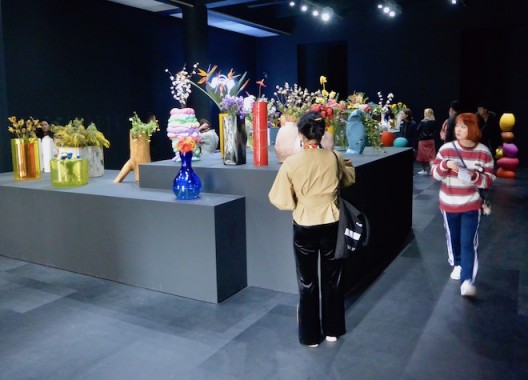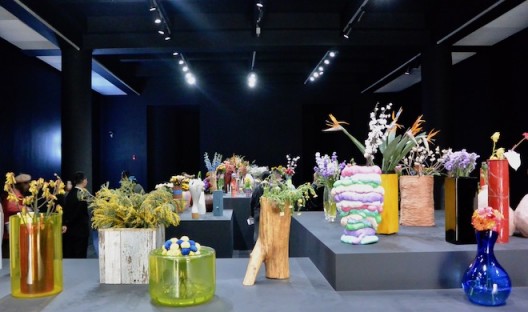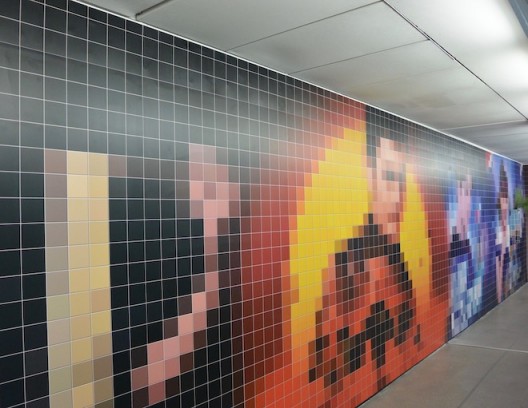By Chris Moore
Tobias Rehberger ‘If You Don’t Use Your Eyes To See You Will Use Them To Cry’
Rockbund Art Museum (20 Hu Qiu Lu, Huangpu District, Shanghai) March 23–May 26, 2019
Curated by Larys Frogier and Billy Tang
Have a butchers
It’s Cockney Rhyming slang: ‘butcher’s hook’ = have a look. Hung on RAM’s façade is a neon sign melding the Chinese and English words for butcher. Inside is the butchery, a tiled black and white jagged-stripy Delicatessen counter with a generous array of cold cuts and jellied offal (Blackbird’s Rockbund Art Museum Butcher Shop, 2019, metal, paint, neon tubes, LED acrylic, and control system). Pig’s heads ogle me. What do they want? Are they threatening or offering? I can’t decide, can’t refuse. ‘To butcher’ also means to massacre. In 2009 Tobias Rehberger was awarded the Golden Lion as best artist in the ‘Making Worlds’ exhibition at the 53rd Venice Biennale. He had a bar there. In Czechia, before the Christmas feast you are meant to starve yourself. If really you’re famished, it is said you will see a golden pig and this is a sign of luck. According to the Chinese zodiac, 2019 is the year of the golden pig, which is particularly auspicious, particularly lucky. Because you eat what you kill. And you kill what you paint.

First Setting
Some things seem well established already but they bear repeating. Rockbund Art Museum (RAM) is located near the North of the Bund, close to the mouth of Suzhou Creek, a block from the Peninsula Hotel, in an area redolent of colonialism. RAM occupies the former Royal Asiatic Society building (1932-1933) one of China’s first museums. The Art Deco building, designed by British architects Palmer and Turner, employs Chinese and Western stylistic elements. Restoration of the building began in 2007 as the cultural element of a wider commercial development project. David Chipperfield, the British minimalist architect renowned for his work on Berlin’s Museum Island, was commissioned to oversee the renovation and reconfiguration. Since opening in 2010, almost uniquely among private museums in Shanghai, RAM has maintained an exceptionally consistent public exhibition and education programs, hosting dozens of high-profile exhibitions by artists, including Cai Guo-Qiang, Zeng Fanzhi, Song Dong, Ugo Rondinone, Philippe Parreno and now Tobias Rehberger.
Tobias was born in 1966 in the postcard-perfect historical town of Esslinging am Neckar in Baden-Württemburg in Germany, not far from Stuttgart, home of Porsche and Mercedes cars. This is why he is a sweet gentle man with a bushy beard who likes cars and food. But back to pigs.

Entreé
The ground floor – the café butchery – is an Amuse Geule. In German, a ‘Gaumenfreude’ –something to amuse the gums, to get the juices flowing! It gives a little taste of what the Chef is going to serve. Next course, next floor, up the narrow stairs.
Rehberger’s somehow works work best in slightly claustrophobic spaces, sepulchral and cryptic. I first saw Rehberger’s work in the flesh years ago when the Boros Collection opened in Berlin in a converted Second World War bunker. There were chandeliers of bands of colored Velcro tape, squiggle lines of color, as if drawn freely in space. The “Infections” series, which began in 2002, start as compositions made by his studio assistants with which Rehberger then intervenes with his own artistic editing but without adding materials. As the exhibition ‘Menu’ describes, this approach as a combination of “controlled chance” and “deferred authorship”. At RAM similar Velcro sculptures hang before the long windows of the second floor foyer (Infections series, 2002-2019, Velcro, cable and lightbulb). There is a ‘light touch’ to these chandeliers, sculptures that illuminate, the space of the foyer but also understanding. Sculptures are traditionally thought of as matter in space, but these “Infections” transmit light, light from inside a drawing composed of swishes of color that curl through air, the two-dimensional colored bands transforming three dimensional space, relying on gravity and material tension to hold their curling forms. Of course, they are also held up by the very cables which powers the light – each element relies for existence upon the others.


From the foyer we enter a crowded room with dark grey walls and carpet. Inside is an opulent display of flowers in vases grouped on large grey plinths. The vases and flowers together form ‘portraits’ of colleagues and friends, representational but not literally (Vase Portraits series, 1997-2019, mixed media). Here there is a vase like a fat cigarette. There one with newspaper. This one has a Strelitzia stems and that one Peace Lilies. The vases are as diverse as the subjects, in shape and materials, including glass, wood, plastic and clay. Like friends, there are more permanent elements (the vases) and more ephemeral ones (the flowers – which eventually wilt and must be replaced, though always with the same type of flowers). There are portraits of Douglas Gordon, Rirkrit Tiravanija, Jorge Pardo, and Sam Taylor-Wood, who each completed the respective portraits representation of their specific relationships with Tobias, by choosing the flowers to be displayed in them. Together the portraits form a matrix of histories, connections and influences. And the smell! The room is heady with the perfume of all the flowers, their pollen floating around and making people sneeze, embodying artistic crosspollination and allergic reactions.


Conversation around the Second Course
Interspersed between the plinths are curious stele, alien yet familiar forms, mildly anthropomorphic somehow seductive sculptures composed of colored egg-like forms (Mother Without Child series, 2019, glazed ceramic). Like us, they are visitors too, come to look at the florist display, pay their respects. They form a link between us and the portraits, asking us to compare and measure. To move about and look from different angles, heights and perspectives. And where are we again? In a museum? A butchery? A boutique? A florist? A crypt? A church? What is a Madonna without a child? This is primal fear – to lose a child (your child!) in a museum, a shopping center…a womb. This is much more than a merely poignant gesture. All portraits, sooner or later, become memento mori and museums and mausoleums are of course monumental too, along with all art, flickering attempts by humans to not forget, to still exist, to not be forgotten.

With a nod to Wim Delvoye’s ‘Cloaca’ (2001) and more vigorously Duchamp’s ‘Fountain’ (2017, a porcelain urinal laid on its back on the floor of a museum and signed “R.Mutt”, a play on the German word for poverty, ‘Armut’), on RAM’s third floor there is a little teahouse. If you want to take tea though you first need to take the piss…in the little cubicle, after which the urine will be converted to water, to make your tea. It’s almost quasi-religious. Almost, and quasi, but definitely ecological! (In the end you can start from behind, 2019, mixed media). The tea house is kind of Asian-esque, with bits of this tradition (some bamboo) and bits of that (a tatami mat). Interpretation has gone awry again, but something useful comes out of that too. Rehberger loves the mistakes, the misinterpretations, the mistranslations, the slippages and strange evolutions, because even errors in communication still involve communication, and it is the evolutionary errors that are creative. Adapt, or end up on a plate in the butchery. It gives pause for thought. Or as one says in German, ‘abwarten und Tee trinken’ – wait and see and drink tee.
Der vierte Gang (the fourth course) – but you can swap courses
So many people queuing, the line stretching down the stairs. I took the lift to the fifth floor mezzanine overlooking the main exhibition hall. You walk in and giant neon signs float tetris-like in the void, right in front of your face but just out of reach, with bright lights and bright colors. Some float like mobiles, their undulating polished metal backs reflecting the mezzanine level walls, which are covered in oversized pixelated abstract tableaus but which through the viewfinder of you mobile phone camera assume the form of people. Up here looking down, there is the giddy feeling of having walked in on the gods. The signage plays on the banality of advertising free merchandise (Free Coffee Free Parking Freedom (plug & play version), 2018, Acrylic, LED, steel ropes, cables and micro-controller based system). Lights go on, lights go off. Music plays as we walk along the passage skirting the void. The tableaus are hard to see up close but gazing over void, through the jumble of signage, the walls on the opposite side are glimpsed.


Walk down the stairs and wander into the main hall. The signage hangs right above your head, inducing mild vertigo and unease. A Chinese song plays. In the center of the room is a podium to support mobile phones, so their users can choose the mood music from their own song library (you can control the brightness and loudness of the hall too). It is engaging and kitsch at the same time (other people’s libraries are always simultaneously fascinating and alienating). Visitors are enjoying the music or politely ignoring it but no one complains. In a sense, the signs for all those free things – coffee, parking, WiFi, whatever – have suddenly been given a voice, a purpose beyond their ordinary existence.

The pixelated tableaux are another matter though. They are playful and oppressive. At first they have a child-like charm, the joy of discovering the trick, something secret being revealed. It is the ordinary life of all of us now, ruled by our mobile devices, with commercial imagery broken down into traceable data binaries and convertible audience metrics to help you get that burnished tan and Fortnite skin. There is a sort of a battle going on here: Social Media vs Relational Aesthetics, with the former demanding attention and the latter asking why?
Of course, most social media is called ‘free’ but the advertisements keep on coming and social engagement becomes addictive, relentless, poisonous and finally terminal. Everyone’s an entertainer, not for 15 minutes but forever, hooked on the next killer app. Here we are now.
Don’t be taken in by the fancy terms though. Rehberger always wants you to look for the errors and the dissonances that allow us to ‘hack’ the system, to get inside. The glitches are revealing, if only you look. (Pixel series, 2019, Digital print on self-adhesive photo paper / USB stick, wood, tiles, grout, and paint)


During the opening days of the exhibition, Blackbird also hosted a cocktail lounge on the 6th floor of RAM with opening times tied to coincide with sunset and sunrise in El Redomon, a place in Argentina, on the exact opposite side of planet to Shanghai, with time marked by a giant sun sculpture suspended from the glass atrium roof. (Forbidden in Heaven, useless in Hell, 2019, metal, paint, neon tubes, LED, acrylic, sockets, and bulbs). The bar recalls Rehberger’s porcelain bar for Encounters at Art Basel Hong Kong in 2014 (‘HOMEAWAY (Oppenheimer Drawings) which also shifted in meaning depending on the presence or absence of staff and guests. ‘Forbidden in Heaven, useless in Hell’ also reprises the themes that began in the Blackbird butchery and café and worked up through RAM’s floors – fortuitous and accidental connections, human and physical, historical and cultural, linguistic and geographic, from artist friendships to cocktail mixes, drawing inspiration from arbitrariness.
Christopher Moore 墨虎恺
Berlin, May 1, 2019